The story of five symbols of the LGBT community
CADE Hildhreth article published on his personal website (United States) on August 10, 2020, freely translated by Silvia Lanzi
It is magnificent if you are between 4.5% of American adults who identify themselves as LGBTQ. Even if it is unquestionably difficult to be in a mainly hetero-novic world, there is a lot of beauty in Amare those who love each other; In addition, we are part of a wonderful community, which is strengthened every day and that always cover our shoulders!
The community is one of the best things of being LGBTQ+: this means that you probably asked yourself* how queer people did, throughout history, to recognize themselves.
To clarify certain aspects of LGBT reality, let's concentrate on the historically more popular homosexual symbols, which have modeled our community.
Five Homosexual Historical Symbols
Here are five symbols that LGBTQ+ people used to show their pride, both in the past and in the present.
1. The rainbow flag
The rainbow flag of gay pride is the symbol of the most recognizable homosexuality of the 21st century. He began to use it in 1978, when he waved Gay and Lesbian Freedom Day Parade for the first time. From that moment he became the increasingly widespread symbol of the LGBT pride.
Today there are several variants of this flag. In some cases black and brown stripes have been added to give support to the color queer people. There are flags also for other queer communities, including the pink-and-red one of the lesbians, the white/pastel and blue pink one of trans people, and the purple of bisexual people.
Today the flag includes strips that represent the experience of color people and those who identify themselves as a transgender, gender nonconforming (GNC) and/or indefinite.
Each color of the original rainbow flag is a demonstration of individuality and solidarity. You can see these colors in many friendly items such as necklaces, rings, hats and so on.
Often people wear clothes with the colors of the rainbow to show that they are LGBT and proud to be, and in this way they find other members of the community much more easily.
2. The green carnation
About a century before the rainbow flag made its appearance, LGBT people, more precisely gay men, used another symbol to meet and recognize themselves.
Men began to pin the green carnation to the Asola at the end of the 19th century. It was a symbol of the movement of aestheticism, but also of "particular" tastes
This symbol was brought for the first time to the gay community by the talented theatrical author Oscar Wilde, LGBT icon if there has ever been one. There was an actor who, on stage, wore a artificially tinted one during the staging of the "Lady Windermere Ventaglio". It was thought that this flower, so unnatural, was strange and wonderful but Wilde laughed on it: it was simply beautiful for the taste of being beautiful.
Since then, men began to wear the flower to show their support to Wilde and his aesthetic philosophy of the "Beauty for the love of beauty". He also became tied to homosexuality, since the propensity for the men of the Irish writer was known. When he pursued Wilde for this reason, many people wore the green carnation to show them their solidarity.
To date, the green carnation is believed to have been one of the first - if not the first - popular symbol of the gay community.
3. The inverted pink triangle
*Notice: we talk about the Holocaust, traumatizing content*
However, not all the symbols of the LGBT community are rooted, such as green carnation, pride and humor. Today the inverted pink triangle is one of the most dated and resistant symbols of homosexuality. Despite his current resilience, his beginnings have been incredibly sad.
During the Holocaust of the Second World War, gays were among the targets of Nazi Germany. In the concentration camps, gay prisoners were obliged to wear overturned pink triangles on clothes to reveal the reason for their captivity, so they would have been "discovered" by the other prisoners and framed in the social hierarchy of the field.
You might think that this is a terrible symbol for the queer community, instead it deserves respect. As happened with the same term "queer", we regained the pink triangle as a symbol of pride and resilience.
In the 70s the gay liberation groups brought him to the fore. Not only was it easily recognizable, but focused attention on the persecutions that LGBTQ people, as a minority group, had faced over time.
Today the pink triangle is a symbol of pride. There are also black and rainbow variants, specifications of the different queer groups.
4. The Labrys
There are tons of historical symbols for gays, and it's fantastic! But could one think: and and lesbian symbols?
The Labrys It is the symbol of both feminism and lesbian pride. It is an ax with two blades commonly used in historical matriarchal societies. Today it symbolizes the strength and independence of heterosexual and lesbian activists.
Often this symbol is overlapped on the lesbian flag or the rainbow one, to show the pride of a woman who loves another woman.
In addition to the Labrys, two symbols of intertwined Venus (known as double Venus) mean women who have women like partner. The symbol of Venus dates back to the third century, but it was in the 70s that the double Venus for lesbian pride began to be used. Since then, women Cis and Transgender have started to use this symbol, together with Labrys, as an expression of one's identity.
5. The lambda
The lambda It is another queer symbol that dates back to the 70s. Tom Doerr, a graphic designer, he chose this Greek letter as a symbol of New York's Gay Activist Alliance.
This happened a year later the motions of Stonewall, and the gay rights movement became the avant -garde of the collective imagination.
But because the lambda? Doerr said the symbol represented "A complete change in energy"; He also added that "It meant the commitment of men and women to reach and defend the human rights of homosexual citizens". Therefore, those who participate in campaigns for LGBT rights use it to show their support for other human beings.
However, the lambda It did not really became popular until 1974, when the International Gay Rights Congress [later became the International Lesbian and Gay Association, better known with the acronym Ilga, ndt] used the symbol for its organization based in Edinburg, which He consolidated his importance more and more in the LGBT community.
Original text: 5 Historical Gay Symbols That Shaped Our Community






